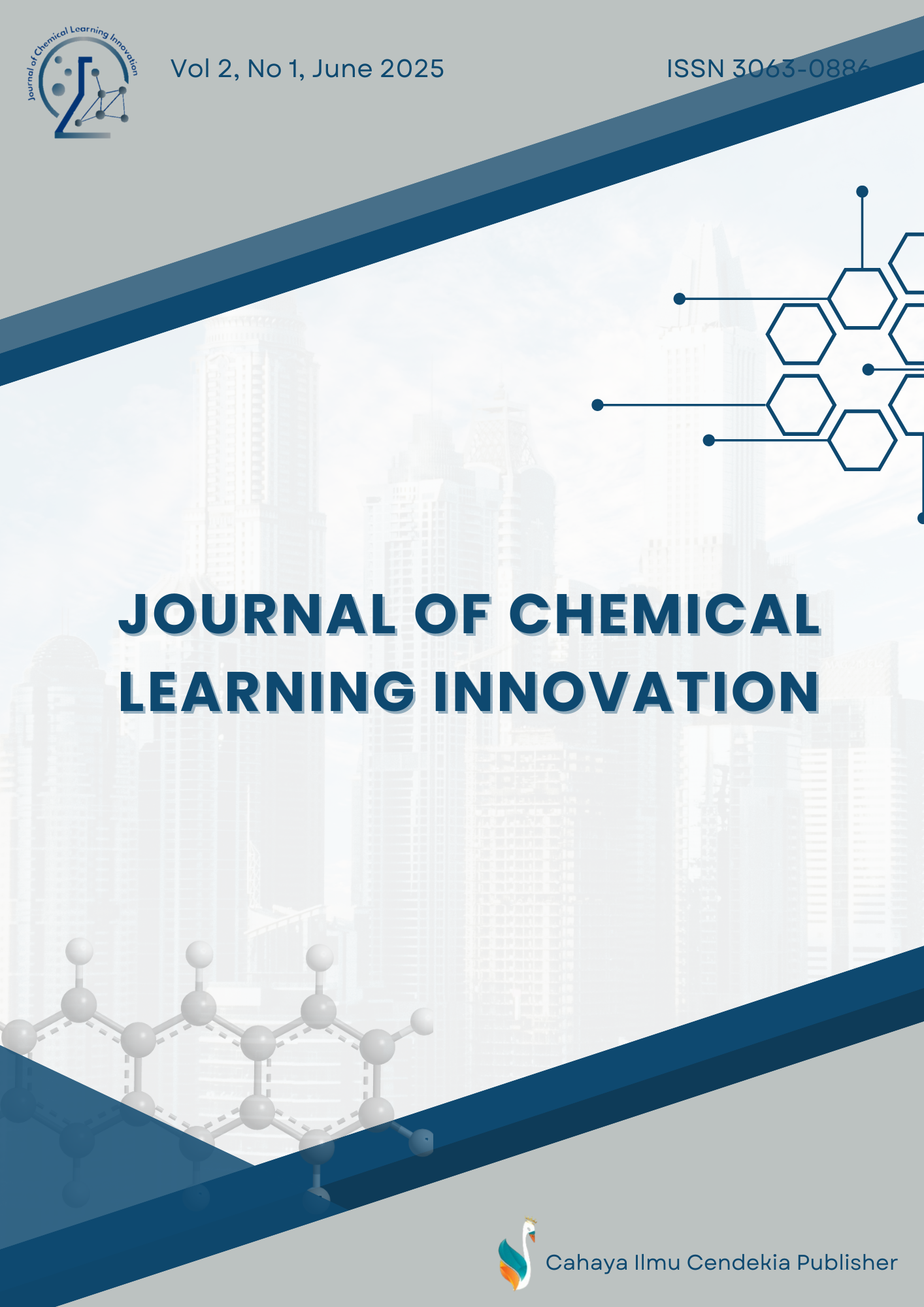From Risk to Safety: Applying Job Safety Analysis in Organic Chemistry Practicals for Future Chemistry Educators
Abstract
Purpose of the study: This study aims to determine the use of Job Safety Analysis in analyzing potential hazards in Organic Chemistry practicums as an effort to implement occupational safety and security for chemistry education students.
Methodology: The method used is descriptive qualitative. The sample of this study was 41 students of the Chemistry Education Study Program. The instruments used were the Job Safety Analysis observation sheet and semi-structured interviews. The stages in analyzing potential hazards using the Job Safety Analysis method are (1) choosing a job, (2) determining the work steps, (3) identifying and analyzing potential hazards in each step of the work and (4) making efforts to control potential hazards.
Main Findings: The results of the study showed 16 potential hazards identified using the Job Safety Analysis method. The results of the analysis of the risk level value (Risk Level) of potential hazards in all work steps divided into four stages of the practicum showed that 19% were (Extreme Risk-Very High Risk), 27% were (High Risk-High Risk), 19% were (Moderate Risk-Moderate Risk) and 35% were (Low Risk-Low Risk).
Novelty/Originality of this study: This study provides an innovative contribution to the development of occupational safety culture in educational environments by integrating JSA as a preventive measure based on practical risk analysis.
References
H. B. Bewota, B. Lemma, A. Wasyhun, and A. Bezabih, “Investigation on Challenges to Implementing Chemistry Experiments in Real Laboratories at Selected Universities in Southern Ethiopia,” J. Int. Educ. Pract., vol. 07, no. 02, pp. 45–61, 2024, doi: 10.30564/jiep.v7i2.5559.
M. Abolhasani and E. Kumacheva, “The rise of self-driving labs in chemical and materials sciences,” 2023, Springer US. doi: 10.1038/s44160-022-00231-0.
J. Yao, “Exploring Experiential Learning: Enhancing Secondary School Chemistry Education Through Practical Engagement and Innovation,” J. Educ. Humanit. Soc. Sci., vol. 22, pp. 475–484, 2023, doi: 10.54097/ehss.v22i.12508.
H. Y. Agustian et al., “Learning outcomes of university chemistry teaching in laboratories: A systematic review of empirical literature,” Rev. Educ., vol. 10, no. 2, pp. 1–41, 2022, doi: 10.1002/rev3.3360.
I. I. Salame and J. Makki, “Examining the Use of PhET Simulations on Students’ Attitudes and Learning in General Chemistry II,” Interdiscip. J. Environ. Sci. Educ., vol. 17, no. 4, p. e2247, 2021, doi: 10.21601/ijese/10966.
M. Seifrid et al., “Autonomous Chemical Experiments: Challenges and Perspectives on Establishing a Self-Driving Lab,” Acc. Chem. Res., vol. 55, no. 17, pp. 2454–2466, 2022, doi: 10.1021/acs.accounts.2c00220.
F. Khoirunnisa, S. Anwar, A. Kadarohman, and Hendrawan, “Analyzing the Implementation of Practicum Organic Compound Separation and Purification in the Chemistry Education Study Program,” in KnE Social Sciences, 2024, pp. 1258–1269. doi: 10.18502/kss.v9i13.16067.
T. J. Wenzel, P. B. C. Forbes, B. C. Galarreta, B. A. Patel, M. Vogel, and D. K. Y. Wong, “Incorporation of analytical chemistry in the undergraduate curriculum: examples from different regions of the world,” Anal. Bioanal. Chem., vol. 416, no. 18, pp. 3997–4006, 2024, doi: 10.1007/s00216-024-05360-3.
S. Liesatyadharma, S. E. Fernandez, M. Jeffina, and Y. Udjaja, “Holoreact: Chemistry experiment game with hologram based to enhance learning on senior high school level,” in Procedia Computer Science, Elsevier B.V., 2022, pp. 453–461. doi: 10.1016/j.procs.2022.12.157.
I. W. Redhana and I. N. Suardana, “Green Chemistry Practicums at Chemical Equilibrium Shift to Enhance Students’ Learning Outcomes,” Int. J. Instr., vol. 14, no. 1, pp. 691–708, 2021, doi: 10.29333/IJI.2021.14142A.
D. F. Sativa, “Improving learning outcomes in chemical change topics through practicum activities,” J. Pijar Mipa, vol. 18, no. 1, pp. 25–29, 2023, doi: 10.29303/jpm.v18i1.4558.
F. F. Hidayah, Gunawan, E. Yuliyanto, S. Qomariyah, M. Imaduddin, and M. C. Djunaidi, “Strengthening Pedagogical Content Knowledge in Designing Laboratory Activity Based on Small-Scale Chemistry Practicum Approach,” Eur. J. Educ. Res., vol. 12, no. 4, pp. 1631–1644, 2023, doi: 10.12973/eu-jer.12.4.1631.
F. Fatemi, A. Dehdashti, and M. Jannati, “Implementation of Chemical Health, Safety, and Environmental Risk Assessment in Laboratories: A Case-Series Study,” Front. Public Heal., vol. 10, no. June, pp. 1–9, 2022, doi: 10.3389/fpubh.2022.898826.
M. Adhyatma, G. E. J. Suyoso, A. Rahagiyanto, F. A. Azhar, and V. Vestine, “Occupational Health and Safety Risk Control at X Teaching Factory,” in IOP Conference Series: Earth and Environmental Science, 2025, pp. 1–13. doi: 10.1088/1755-1315/1446/1/012007.
T. P. ADESOPE, I. M. AKANBI, W. O. MURITALA, A. M. OGUNTOLA, N. A. IDOWU, and O. ABODUNRIN, “KNOWLEDGE, PERCEPTION AND PRACTICES ON CHEMICAL RISK AND SAFETY AMONG LABORATORY WORKERS IN OGBOMOSO, OYO STATE, NIGERIA.,” Int. J. Public Heal. Clin. Sci., vol. 12, no. 1, 2025.
E. Tziakou, A. G. Fragkaki, and A. Platis, “Identifying risk management challenges in laboratories,” Accredit. Qual. Assur., vol. 28, no. 4, pp. 167–179, 2023, doi: 10.1007/s00769-023-01540-3.
A. I. Asmarany, Djunaedi, A. A. Hakim, A. Saefudin, and L. Judijanto, “Effective Laboratory Management: Efforts to Improve Science Education Management in Islamic Boarding Schools,” J. Penelit. Pendidik. IPA, vol. 10, no. 8, pp. 5673–5680, 2024, doi: 10.29303/jppipa.v10i8.8250.
C. Chatigny, “Occupational health and safety in initial vocational training: Reflection on the issues of prescription and integration in teaching and learning activities,” Saf. Sci., vol. 147, p. 105580, 2022.
M. D. Threeton, K. Kwon, J. A. Fleck, R. B. Ketchem, and L. Farzam, “An investigation of instructional practices which promote occupational safety and health,” Int. J. Occup. Saf. Ergon., vol. 27, no. 3, pp. 902–910, 2021, doi: 10.1080/10803548.2019.1659000.
I. K. Sudiana and I. W. Suja, “Basic Chemistry Practicum Handbook with Occupational Health and Safety (K3) to Prevent Work Accidents in Laboratory: Validity and Feasibility,” J. Pendidik. dan Pengajaran, vol. 54, no. 1, p. 181, 2021, doi: 10.23887/jpp.v54i1.31934.
I. Aslan, “Ranking and comparing occupational health and safety system performance indicators in hospitals by the analytic hierarchy process,” Int. J. Occup. Saf. Ergon., vol. 28, no. 3, pp. 1937–1947, 2022.
M. Hao and Y. Nie, “Hazard identification, risk assessment and management of industrial system: Process safety in mining industry,” Saf. Sci., vol. 154, p. 105863, 2022, doi: 10.1016/j.ssci.2022.105863.
S. Schmeisser et al., “New approach methodologies in human regulatory toxicology – Not if, but how and when!,” Environ. Int., vol. 178, no. July, pp. 1–17, 2023, doi: 10.1016/j.envint.2023.108082.
F. Ghasemi, A. Doosti-Irani, and H. Aghaei, “Applications, Shortcomings, and New Advances of Job Safety Analysis (JSA): Findings from a Systematic Review,” Saf. Health Work, vol. 14, no. 2, pp. 153–162, 2023, doi: 10.1016/j.shaw.2023.03.006.
A. Adriaensen, F. Costantino, G. Di Gravio, and R. Patriarca, “Teaming with industrial cobots: A socio-technical perspective on safety analysis,” Hum. Factors Ergon. Manuf., vol. 32, no. 2, pp. 173–198, 2022, doi: 10.1002/hfm.20939.
V. Patel, A. Chesmore, C. M. Legner, and S. Pandey, “Trends in Workplace Wearable Technologies and Connected‐Worker Solutions for Next‐Generation Occupational Safety, Health, and Productivity,” Adv. Intell. Syst., vol. 4, no. 1, pp. 1–30, 2022, doi: 10.1002/aisy.202100099.
P. E. Tenda and F. R. Soeharto, “Assessment of Job Risks in the Chemical Laboratory of the Pharmacy Study Program with Job Safety Analysis (JSA) Techniques,” J. Kesehat. Prima, vol. 15, no. 2, p. 125, 2021, doi: 10.32807/jkp.v15i2.689.
N. I. F. Kusumaningtyas and T. Satrio, “Evaluation of the Occupational Health and Safety Implementation in the Pharmacy Laboratory of University X Surabaya,” Indones. J. Occup. Saf. Heal., vol. 11, no. 1, pp. 43–53, 2022, doi: 10.20473/ijosh.v11i1.2022.43-53.
A. S. Mariawati, L. Herlina, and A. Umyati, “Analysis of Potential Risk Hazard with The HIRA and HAZOP Approach (Case Study: Laboratory of Engineering Faculty, Universitas Sultan Ageng Tirtayasa),” Int. J. Innov. Sci. Res. Technol., vol. 6, no. 10, pp. 634–642, 2021, [Online]. Available: www.ijisrt.com634
P. Bęś and P. Strzałkowski, “Analysis of the Effectiveness of Safety Training Methods,” Sustain., vol. 16, no. 7, pp. 1–21, 2024, doi: 10.3390/su16072732.
W. Dewanto, “the Supervision on the Implementation of Job Safety Analysis (Jsa) As the Effort in Increasing Behavior Based Safety (Bbs) on High Tense Working Units (Hvwu) of Pt. Pln (Persero) Malang Area,” Nusant. Econ. Entrep. Journals, vol. 1, no. 1, pp. 1–16, 2023, doi: 10.59971/necent.v1i1.1.
K. A. Osakwe, “The Possibilities of Simultaneous Operation (SIMOPs) and Practicality of Positive Pressure Habitat in a Hazardous Industry: Where Process Safety Meets Occupational Hygiene,” Curr. J. Appl. Sci. Technol., vol. 40, no. 13, pp. 28–37, 2021, doi: 10.9734/cjast/2021/v40i1331390.
N. A. Shuaib et al., “Assessing risks and control measures on a welding workshop in Malaysia,” in AIP Conference Proceedings, AIP Publishing, 2021.
J. Conzen, S. Lakshmipathy, A. Kapahi, S. Kraft, and M. Didomizio, “Journal of Loss Prevention in the Process Industries Lithium ion battery energy storage systems ( BESS ) hazards,” J. Loss Prev. Process Ind., vol. 81, no. March 2022, pp. 1–9, 2023.
D. Settembre-Blundo, R. González-Sánchez, S. Medina-Salgado, and F. E. García-Muiña, “Flexibility and Resilience in Corporate Decision Making: A New Sustainability-Based Risk Management System in Uncertain Times,” Glob. J. Flex. Syst. Manag., vol. 22, no. December, pp. 107–132, 2021, doi: 10.1007/s40171-021-00277-7.
A. Laurent and B. Fabiano, “A Critical Perspective on the Impact of Industry 4.0’s New Professional Safety Management Skills on Process Safety Education,” Chem. Eng. Trans., vol. 91, no. February, pp. 67–72, 2022, doi: 10.3303/CET2291012.
A. Babalola, P. Manu, C. Cheung, A. Yunusa-Kaltungo, and P. Bartolo, “Applications of immersive technologies for occupational safety and health training and education: A systematic review,” Saf. Sci., vol. 166, no. May, pp. 1–16, 2023, doi: 10.1016/j.ssci.2023.106214.
V. Laciok, K. Sikorova, B. Fabiano, and A. Bernatik, “Trends and opportunities of tertiary education in safety engineering moving towards safety 4.0,” Sustain., vol. 13, no. 2, pp. 1–21, 2021, doi: 10.3390/su13020524.
V. Zaroushan and F. Khajehnasiri, “Job Safety Analysis: A Practical Method to Improve Safety in Healthcare Centers During COVID-19 Pandemic,” Heal. Emergencies Disasters Q., vol. 7, no. 4, pp. 167–169, 2020, doi: 10.32598/hdq.7.4.450.1.
M. Palega, “Application of the job safety analysis (jsa) method to assessment occupational risk at the workplace of the laser cutter operator,” Manag. Prod. Eng. Rev., vol. 12, no. 3, pp. 40–50, 2021, doi: 10.24425/mper.2021.138529.
A. Abdurrahmansyah, H. Sugilar, I. Ismail, and D. Warna, “Online Learning Phenomenon: From the Perspective of Learning Facilities, Curriculum, and Character of Elementary School Students,” Educ. Sci., vol. 12, no. 8, pp. 1–18, 2022, doi: 10.3390/educsci12080508.
D. Badampudi, F. Fotrousi, B. Cartaxo, and M. Usman, “Reporting Consent, Anonymity and Confidentiality Procedures Adopted in Empirical Studies Using Human Participants,” E-Informatica Softw. Eng. J., vol. 16, no. 1, pp. 1–24, 2022, doi: 10.37190/e-Inf220109.
R. Lina, “Improving Product Quality and Satisfaction as Fundamental Strategies in Strengthening Customer Loyalty,” Akad. J. Mhs. Ekon. Bisnis, vol. 2, no. 1, pp. 19–26, 2022, doi: 10.37481/jmeb.v2i1.245.
M. Botha and E. Cage, “‘Autism research is in crisis’: A mixed method study of researcher’s constructions of autistic people and autism research,” Front. Psychol., vol. 13, no. November, pp. 1–22, 2022, doi: 10.3389/fpsyg.2022.1050897.
Copyright (c) 2025 Dwi Ahmad Nur Ramadhani, Basil Marasinghe, Marilyn B. Castillo

This work is licensed under a Creative Commons Attribution 4.0 International License.
Authors who publish with this journal agree to the following terms:
- Authors retain copyright and acknowledge that the Journal of Chemical Learning Innovation is the first publisher licensed under a Creative Commons Attribution 4.0 International License.
- Authors are able to enter into separate, additional contractual arrangements for the non-exclusive distribution of the journal's published version of the work (e.g., post it to an institutional repository or publish it in a book), with an acknowledgment of its initial publication in this journal.
- Authors are permitted and encouraged to post their work online (e.g., in institutional repositories or on their website) prior to and during the submission process, as it can lead to productive exchanges and earlier and greater citation of published work.





.png)
.png)










